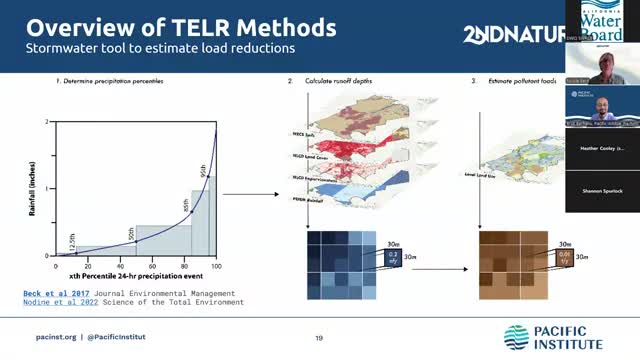Data reveals staggering stormwater runoff across US urban areas
September 15, 2024 | State Water Resources Control Board, Agencies under Office of the Governor, Executive, California
This article was created by AI summarizing key points discussed. AI makes mistakes, so for full details and context, please refer to the video of the full meeting. Please report any errors so we can fix them. Report an error »

In a recent government meeting, experts discussed innovative methodologies for analyzing stormwater runoff across the United States, emphasizing the importance of accurate data in climate adaptation efforts. The team presented a new approach that preprocesses precipitation data over various time frames—ranging from one year to thirty years—using a mathematical technique known as the trapezoid method. This allows for reliable estimates of runoff and pollution generation at a fine spatial scale of 30 meters.
The analysis, validated across diverse catchment areas, revealed significant findings regarding urban stormwater runoff. The team reported that the total annual average runoff generated nationwide is approximately 60 million acre-feet, which aligns closely with previous estimates from 2020. This volume represents about 90% of the public water supply withdrawals recorded by the U.S. Geological Survey in 2015.
The discussion highlighted the increasing impervious surfaces in urban areas as a key factor driving stormwater runoff. Notably, the largest urban areas, such as New York and Houston, were identified as having the highest runoff volumes, with each generating around 2 million acre-feet annually. In contrast, Los Angeles, despite its large population, did not rank among the top 20 urban areas for runoff due to its lower rainfall and impervious area.
The findings underscore the critical need for updated methodologies and localized data to inform stormwater management and climate adaptation strategies effectively. The meeting concluded with a call for continued collaboration and data sharing to enhance urban planning and environmental resilience across the nation.
The analysis, validated across diverse catchment areas, revealed significant findings regarding urban stormwater runoff. The team reported that the total annual average runoff generated nationwide is approximately 60 million acre-feet, which aligns closely with previous estimates from 2020. This volume represents about 90% of the public water supply withdrawals recorded by the U.S. Geological Survey in 2015.
The discussion highlighted the increasing impervious surfaces in urban areas as a key factor driving stormwater runoff. Notably, the largest urban areas, such as New York and Houston, were identified as having the highest runoff volumes, with each generating around 2 million acre-feet annually. In contrast, Los Angeles, despite its large population, did not rank among the top 20 urban areas for runoff due to its lower rainfall and impervious area.
The findings underscore the critical need for updated methodologies and localized data to inform stormwater management and climate adaptation strategies effectively. The meeting concluded with a call for continued collaboration and data sharing to enhance urban planning and environmental resilience across the nation.
View full meeting
This article is based on a recent meeting—watch the full video and explore the complete transcript for deeper insights into the discussion.
View full meeting
